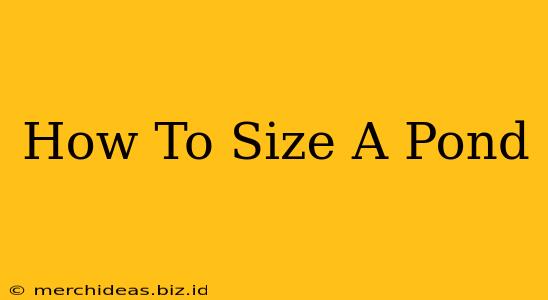Dreaming of a tranquil backyard pond teeming with life? Before you break ground, careful planning is crucial. Sizing your pond correctly is the foundation of a healthy and thriving aquatic ecosystem. This comprehensive guide will walk you through the key considerations for determining the perfect size for your pond.
Factors Influencing Pond Size
Several factors interact to determine the ideal size of your pond. Consider these carefully before you begin:
1. Available Space: The Obvious Starting Point
The most straightforward factor is the physical space you have available in your yard. Measure the area you're considering and sketch a rough outline. Remember to account for pathways, landscaping, and any other features you plan to incorporate around the pond. Don't overestimate your space! A pond that's too large can overwhelm your yard and become difficult to maintain.
2. Desired Pond Inhabitants: Fish, Plants, and More
The types and number of plants and animals you plan to keep significantly impact pond size. Larger fish like koi require significantly more space than smaller goldfish. Similarly, a diverse range of aquatic plants needs ample room to grow and thrive. Research the space requirements of your chosen species before making any decisions. A crowded pond is a stressed pond, leading to health issues and potential die-offs.
3. Pond Depth: Creating a Balanced Ecosystem
Pond depth affects water temperature, oxygen levels, and the types of plants and animals that can survive within it. A shallow pond will heat up quickly, potentially harming fish in summer and freezing solid in winter. A deeper pond offers more stable conditions and allows for different plant zones, creating a more diverse habitat. Consider incorporating varying depths within your pond design – shallow shelves for marginal plants and deeper areas for fish to shelter.
4. Maintenance and Budget: Realistic Expectations
Larger ponds require more maintenance, including more frequent cleaning and potentially a more powerful filtration system. This translates to higher upfront costs and ongoing expenses. Assess your budget and realistically evaluate your time commitment before deciding on a pond's size. A smaller pond is easier to maintain and may be a better starting point for beginners.
5. Aesthetic Considerations: Harmony with Your Landscape
Think about how your pond will integrate with the overall landscape design of your yard. A pond that's too small can look insignificant, while one that's too large can dominate the space. Strive for a balance that complements your existing garden and architectural style.
Determining the Right Size: Practical Tips
Once you’ve considered the factors above, you can start making a more concrete plan. Here are some practical tips:
- Start Small: If you're unsure, begin with a smaller pond and expand it later if needed.
- Professional Consultation: Consult with a landscape professional or pond specialist for personalized advice and design assistance. They can help you assess your site and create a plan that’s both aesthetically pleasing and ecologically sound.
- Online Calculators: Several online calculators can help you estimate the volume of your pond based on its dimensions. This is important for determining the correct size of filtration and aeration equipment.
Beyond the Size: Other Crucial Considerations
Remember that the size of your pond is just one piece of the puzzle. You also need to consider:
- Water source: Where will you get your water?
- Filtration and aeration: What kind of filtration system will you need?
- Planting scheme: What plants will best suit your pond and its inhabitants?
By carefully considering all of these factors, you can create a stunning and thriving pond that brings years of enjoyment to your backyard. Happy pond building!
